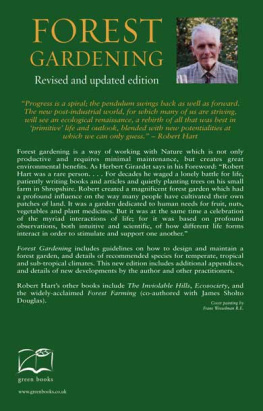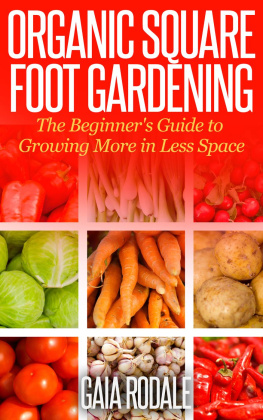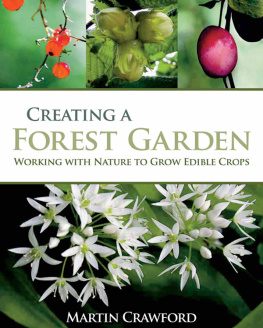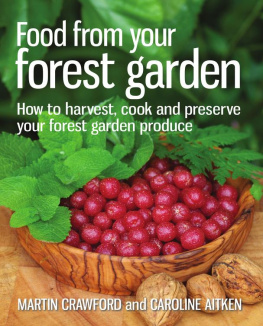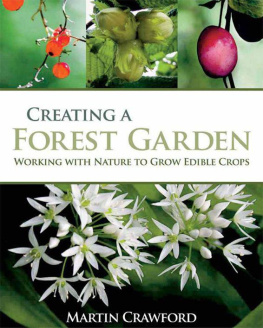F OREST
G ARDENING
F OREST
G ARDENING
Rediscovering Nature & Community
in a Post-Industrial Age

R OBERT A de J H ART
Revised & updated edition

This revised edition
first published in 1996 by
Green Earth Books,
an imprint of Green Books,
Foxhole, Dartington
Totnes, Devon, TQ9 6EB
Reprinted 2001 with a revised Foreword
Reprinted 2009 (without colour plates)
First published in ebook formats 2010
1991-2010 the estate of Robert A. de J. Hart
All rights reserved
British Library Cataloguing in Publication Data
available on request
Print format ISBN 978 1 900322 02 7
PDF format ISBN 978 1 907448 36 2
ePub format ISBN 978 1 907448 37 9
A CKNOWLEDGEMENTS
The author and publishers would like to thank Amy Elvey and Susan Trill for their line drawings that appear throughout the book; the International Institute for Environment & Development for their kind permission to use three illustrations of forest gardens in Africa (from Paul Harrisons The Greening of Africa). And finally, special thanks are due to Frans Wesselman for his generosity in donating the striking cover picture.
L IST OF I LLUSTRATIONS
To ELENA
who loves the Forest Garden

F OREWORD
T en years ago the first edition of Forest Gardening came out, and it has attracted a large readership. That is because it is a book of hope; but even more than that, it is a book of practical instructions for a sustainable future of our own making. Sadly Robert Hart died in 2000, and can no longer enrich our lives with new inspiration. Forest Gardening remains perhaps his greatest and most enduring legacy and I am delighted that Green Books is continuing to keep the book in print.
Robert wanted one thing more than anything else: he wanted us to grow forests food forests. We can plant them all around us in our communities, on urban wasteland and in our own backyards. By showing us how, he has touched a deep need in many of us, in an age in which the only certainty is change, and thus insecurity. Trees dont race down motorways: they stand still. They are always there in the same place, and the only changes they undergo are those of the seasons, steadily, year after year.
Robert Hart was a rare person. A man utterly convinced of a cause, an imaginative experimenter eloquent in expressing his message and with a stamina second to none. For decades he waged a lonely battle for life, patiently writing books and articles and quietly planting trees on his small farm in Shropshire. Robert created a forest garden which had a profound influence on the way we cultivate our patches of land. It was a garden dedicated to human needs for fruit, nuts, vegetables and plant medicines. But it was at the same time a celebration of the myriad interactions of life; for it was based on profound observations, both intuitive and scientific, of how different life forms interact in order to stimulate and support one another. His forest garden was, at the same time, a revolutionary new creation and a rediscovery of ancient plant knowledge.
For well over twenty years Robert taught the message of the goodness of life. If only we rediscovered the patient art of cultivation we would have little need for the excesses of modern technology. For him life starts and ends with trees. The Earth was once covered with forests. We have stripped away much of its living skin. Today we need to put trees back, allowing them again to root in the living Earth. But there are many people now and we need to plant forests to support our numbers. We need to practice forestry, as well as forest farming or, as this book so eloquently shows, small scale forest gardening.
I have shared Roberts interests for many years. In my travels as a writer and film-maker I have gone out of my way to find forest gardeners, in the tropics and the subtropics and in the temperate regions. Like Robert I have become convinced that cultivating trees is a great art, not of survival, but of living. Nature offered our ancestors an abundance of fruit and nut trees. The people before us hunter gatherers, forest farmers and orchard cultivators all over the world used the great imagination and creativity inherent in human nature to select and breed a huge variety of tree crops suitable for most of the climatic conditions on Earth. The pygmies in Africa, the Amerindians and the forest people of Asia rose to the challenge of life in the botanically most diverse regions on Earth by naming, selecting and cultivating a most astonishing variety of food trees, which they improved through deliberate breeding. The forest gardens, or agroforestry systems, in many parts of the tropics are a tribute to their patient art of cultivation. They support some of the highest population densities on Earth and they do so sustainably, both in terms of maintaining soil fertility as well as acceptable climatic conditions. For in hot climates wherever tree cover is maintained the soil is shaded and the temperatures remain moderate. The typical temperature in a mature tropical forest averages around 26C, but when the forest is removed for cattle ranching, or annual crops, average daytime temperature rises by some 10C.
Forest gardens are not pristine environments they are forests modified to suit human needs. But tree gardens, too, are shady, moist and temperate, not quite as cool as the original rainforest, but temperate nevertheless. The great multi-storey food forests of the Chagga on the slopes of Kilimanjaro in Tanzania, for instance, are wonderfully cool but the plains below, now devoid of trees, swelter with heat. The Chagga gardens also happen to support the greatest population densities anywhere in East Africa. In the Amazon I have visited several different types of forest gardens. Some, like the tree farms of the caboclos in the flood plains of the river near Belem, have been sustained for centuries. Others have been established quite recently on abandoned cattle ranches by patient farmers, advised and supported by sympathetic agronomists. There is no doubt in my mind that techniques are available for establishing sustainable forest farming systems on the wastelands of the Amazon even on relatively poor soils. Nature has extraordinary powers of recovery in the face of devastation, but people involved in environmental restoration have to have a profound understanding of the complex interactions that take place in the natural world.
Robert Hart was a man who set out with a determination to help turn wasteland into paradise again. His patient work on his patch of land in Shropshire has led the way for inventing forest farming systems suitable for temperate climatic conditions. Our cool weather does not give us nearly the same range of tree crops that are suitable even for the Mediterranean.
But, as Robert shows, we do have the choice of a far greater range of perennial crops than we are presently aware of. And if plant breeders took up the challenge of working on greater varieties of edible fruits and nuts, within a decade these would make their appearance in our gardens. Robert grew crops from all over the world without any discrimination as to their origins. America, China, Persia, Russia and western Europe can supply crops suitable for temperate climatic conditions. This botanical internationalism transcends the rather limited range of species available here as a result of the genetic extinctions caused by our last ice age. But in the tropics, too, African forest farmers are happy to use South American crops and vice versa. Inventiveness has always been a trait of pioneering farmers. Robert Hart, as this book shows, was a true innovator, who brought the message home into our back gardens that, yes, we can produce an abundance of foods for self-reliance in a rather small space and we can have a great deal of enjoyment doing so. Nature is our origin and our destination, even if technocrats try and persuade us otherwise. But even the body of an engineer or a racing driver, whose glory is his machine, will turn to dust. And that dust is not going to produce a car, but it may feed a tree, one day, if it is allowed to do so.
Next page
